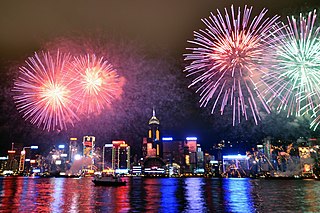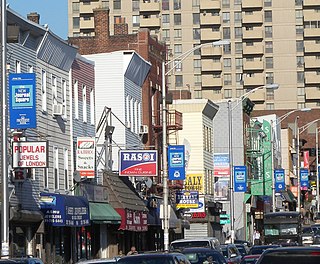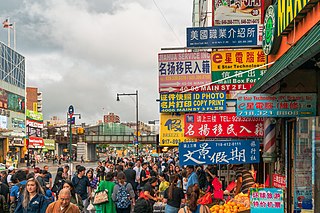Related Research Articles

Queens is a borough of New York City, coextensive with Queens County, in the U.S. state of New York. Located near the western end of Long Island, it is the largest of the five New York City boroughs by area. It is bordered by the borough of Brooklyn and by Nassau County to its east, and shares maritime borders with the boroughs of Manhattan, the Bronx, and Staten Island, as well as with New Jersey. Queens is the most linguistically and ethnically diverse place in the world.

Lunar New Year is the beginning of a new year based on lunar calendars or, informally but more widely, lunisolar calendars. Lunar calendars follow the lunar phase while lunisolar calendars follow both the lunar phase and the time of the solar year. The event is celebrated by numerous cultures in various ways at diverse dates.

Corona is a neighborhood in the borough of Queens in New York City. It borders Flushing and Flushing Meadows–Corona Park to the east, Jackson Heights to the west, Forest Hills and Rego Park to the south, Elmhurst to the southwest, and East Elmhurst to the north. Corona's main thoroughfares include Corona Avenue, Roosevelt Avenue, Northern Boulevard, Junction Boulevard, and 108th Street.

New York City is a large and ethnically diverse metropolis. It is the largest city in the United States, and with a long history of international immigration. The New York region continues to be by far the leading metropolitan gateway for legal immigrants admitted into the United States. The city is the geographical and demographic center of both the Northeast megalopolis and the New York metropolitan area, the largest metropolitan area in the U.S. by both population and urban area. With over 20.1 million people in its metropolitan statistical area and 23.5 million in its combined statistical area as of 2020, New York City is one of the world's most populous megacities.

Bangladeshi Americans are American citizens with Bangladeshi origin or descent. Bengali Americans are predominantly Bangladeshi Americans and are usually Bengali speaking Muslims. Since the early 1970s, Bangladeshi immigrants have arrived in significant numbers to become one of the fastest growing ethnic groups in the U.S. New York City is home to two-thirds of the Bangladeshi American population. Meanwhile, Paterson, New Jersey; Atlantic City, New Jersey; and Monroe Township, Middlesex County, New Jersey are also home to notable Bangladeshi communities.
The demographics of Brooklyn reveal a very diverse borough of New York City and a melting pot for many cultures, like the city itself. Since 2010, the population of Brooklyn was estimated by the Census Bureau to have increased 3.5% to 2,592,149 as of 2013, representing 30.8% of New York City's population, 33.5% of Long Island's population, and 13.2% of New York State's population. If the boroughs of New York City were separate cities, Brooklyn would be the third largest city in the United States after Los Angeles and Chicago.

The demographics of Queens, the second-most populous borough in New York City, are highly diverse. No racial or ethnic group holds a majority in the borough.

Since its founding in 1625 by Dutch traders as New Amsterdam, New York City has been a major destination for immigrants of many nationalities who have formed ethnic enclaves, neighborhoods dominated by one ethnicity. Freed African American slaves also moved to New York City in the Great Migration and the later Second Great Migration and formed ethnic enclaves. These neighborhoods are set apart from the main city by differences such as food, goods for sale, or even language. Ethnic enclaves provide inhabitants security in work and social opportunities, but limit economic opportunities, do not encourage the development of English speaking, and keep immigrants in their own culture.

Avenue U is a commercial street located in Brooklyn, New York City. This avenue is a main thoroughfare throughout its length. Avenue U begins at Stillwell Avenue in Gravesend and ends at Bergen Avenue in Bergen Beach, while serving the other Brooklyn neighborhoods of Gravesend, Homecrest, Sheepshead Bay, Marine Park, and Mill Basin along its route.
Asian people are the people of the continent of Asia. The term may also refer to their descendants.

Indian Americans are people with ancestry from India who are citizens or permanent residents of the United States. The terms Asian Indian and East Indian are used to avoid confusion with Native Americans in the United States, who are also referred to as "Indians" or "American Indians". With a population of more than 5.1 million, Indian Americans make up approximately 1.35% of the U.S. population and are the largest group of South Asian Americans, the largest Asian-alone group, and the largest group of Asian Americans after Chinese Americans. Indian Americans are the highest-earning ethnic group in the United States.

The first Brooklyn Chinatown, was originally established in the Sunset Park area of the New York City borough of Brooklyn. It is one of the largest and fastest growing ethnic Chinese enclaves outside of Asia, as well as within New York City itself. Because this Chinatown is rapidly evolving into an enclave predominantly of Fuzhou immigrants from Fujian Province in China, it is now increasingly common to refer to it as the Little Fuzhou or Fuzhou Town of the Western Hemisphere; as well as the largest Fuzhou enclave of New York City.
Guyanese Americans are American people with Guyanese ancestry or immigrants who were born in Guyana. Guyana is home to people of many different national, ethnic and religious origins. As of 2019, there are 231,649 Guyanese Americans currently living in the United States. The majority of Guyanese live in New York City – some 140,000 – making them the fifth-largest foreign-born population in the city.

Jumaane D. Williams is an American activist and politician who has served as the New York City Public Advocate since 2019. He is a former member of the New York City Council from the 45th district, which includes East Flatbush, Flatbush, Flatlands, Marine Park, and Midwood in Brooklyn.

The New York metropolitan area is home to the largest and most prominent ethnic Chinese population outside of Asia, hosting Chinese populations representing all 34 provincial-level administrative units of China. The Chinese American population of the New York City metropolitan area was an estimated 893,697 as of 2017, constituting the largest and most prominent metropolitan Asian national diaspora outside Asia. New York City itself contains by far the highest ethnic Chinese population of any individual city outside Asia, estimated at 628,763 as of 2017.

There are multiple Chinatowns in the borough of Queens in New York City. The original Queens Chinatown emerged in Flushing, initially as a satellite of the original Manhattan Chinatown, before evolving its own identity, surpassing in scale the original Manhattan Chinatown, and subsequently, in turn, spawning its own satellite Chinatowns in Elmhurst, Corona, and eastern Queens. As of 2023, illegal Chinese immigration to New York has accelerated, and its Flushing neighborhood has become the present-day global epicenter receiving Chinese immigration as well as the international control center directing such migration. As of 2024, a significant new wave of Chinese Muslims is fleeing religious persecution in northwestern China’s Xinjiang Province and seeking religious freedom in New York, and concentrating in Queens.

In the New York metropolitan area, Filipinos constitute one of the largest diasporas in the Western Hemisphere. By 2014 Census estimates, the New York City-Northern New Jersey-Long Island, NY-NJ-CT-PA Combined Statistical Area was home to 262,375 Filipino Americans, 221,612 (84.5%) of them uniracial Filipinos.

Indians in the New York City metropolitan area constitute one of the largest and fastest-growing ethnicities in the New York City metropolitan area of the United States. The New York City region is home to the largest and most prominent Indian American population among metropolitan areas by a significant margin, enumerating 711,174 uniracial individuals based on the 2013–2017 U.S. Census American Community Survey estimates. The Asian Indian population also represents the second-largest metropolitan Asian national diaspora both outside of Asia and within the New York City metropolitan area, following the also rapidly growing and hemisphere-leading population of the estimated 893,697 uniracial Chinese in the New York City metropolitan area in 2017.
New York City is home to the second-largest Taiwanese American population, after the Los Angeles metropolitan area, California, enumerating an estimated 40,000 to 50,000 individuals as of 2020.
According to the 2020 U.S. Census, there were a total of 8,804,190 residents in New York City. A total of 2,719,856 residents identified as Non-Hispanic White, followed by 2,490,350 people of Hispanic origin (28.3%), 1,776,891 Black residents (20.2%) and 1,373,502 people of Asian origin (15.6%). A total of 143,632 residents identified with a different race (1.6%), while 299,959 identified with two or more races (3.4%).
References
- ↑ Jonathan H. X. Lee; Kathleen M. Nadeau (2011). Encyclopedia of Asian American Folklore and Folklife. ABC-CLIO. pp. 333–334. ISBN 978-0-313-35066-5.
Since the Philippines was colonized by Spain, Filipino Americans in general can speak and understand Spanish too.
- ↑ Kirk Semple (June 23, 2011). "Asian New Yorkers Seek Power to Match Numbers". The New York Times . Retrieved July 5, 2011.
Asians, a group more commonly associated with the West Coast, are surging in New York, where they have long been eclipsed in the city's kaleidoscopic racial and ethnic mix. For the first time, according to census figures released in the spring, their numbers have topped one million—nearly 1 in 8 New Yorkers—which is more than the Asian population in the cities of San Francisco and Los Angeles combined.
- ↑ "Asian American Statistics". Améredia Incorporated. Retrieved July 5, 2011.
- ↑ "ACS DEMOGRAPHIC AND HOUSING ESTIMATES 2017 American Community Survey 1-Year Estimates Chinese alone - New York City, New York". U.S. Census Bureau. Archived from the original on February 14, 2020. Retrieved February 15, 2019.
- ↑ Hong, Nicole (2021-10-18). "Inside the N.Y.C. Neighborhood With the Fastest Growing Asian Population". The New York Times. ISSN 0362-4331 . Retrieved 2021-11-25.
- ↑ David Robinson (September 11, 2023). "NY makes Asian Lunar New Year a public school holiday. When is it in 2024?". USA TODAY Network. Retrieved December 26, 2023.
- 1 2 SANDRA ESCALLÓN and TELEMUNDO 47 (December 26, 2023). "These NY and NJ laws will take effect in 2024". NBC New York. Retrieved December 26, 2023.
New school holidays Hochul signed legislation to declare Asian Lunar New Year a public school holiday across New York State. Legislation (A.7768/S.7573) would ensure schools are not in session on Lunar New Year, underscoring Hochul's commitment to supporting and protecting New York's AAPI community. The Democrat also signed legislation that makes Diwali a school holiday for New York City public schools. Legislation S.7574/A.7769 requires that all public schools in New York City be closed on the 15th day of the eighth month of the Indian calendar in each year, which is known as Diwali.
{{cite web}}: CS1 maint: numeric names: authors list (link) - ↑ "Table SF1-P9 NYC: Total Asian Population by Selected Subgroups" (PDF). NYC.gov. Archived from the original (PDF) on May 5, 2012. Retrieved August 27, 2011.
- ↑ "Asian/Pacific/American Studies". apa.as.nyu.edu.
- ↑ "Interference Archive - Serve the People: The Asian American Movement in New York". interferencearchive.org.
